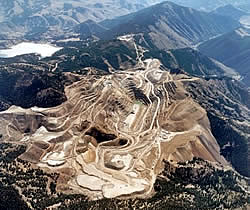Molybdenum occurs in nature in chemical combination with other elements. There are various molybdenum-bearing minerals, but the only one of commercial significance is molybdenite (MoS2) - a natural molybdenum sulfide.
In ore bodies, molybdenite is generally present in quantities from 0.01-0.25%. It can occur as the sole mineralization, but it is often associated with sulfide minerals of other metals, notably copper.
Depending upon the minerals contained in the ore body and their quality, molybdenum mines are grouped in three classes:
- Primary mines, where the recovery of molybdenite is the sole objective
- By-product mines, where the recovery of copper-bearing ores is the primary objective, and molybdenite recovery provides additional economic value
- Co-product mines, where both molybdenite and copper-bearing minerals are recovered
If the ore lies close to the surface, mining is done using open cast pit technology. The overburden is excavated to reveal the ore body for easy extraction.
If the ore lies deep underground, the underground block caving mining technique is used, where large blocks of ore are undercut and allowed to collapse under their own weight. The resulting rock is brought to the surface for processing.


